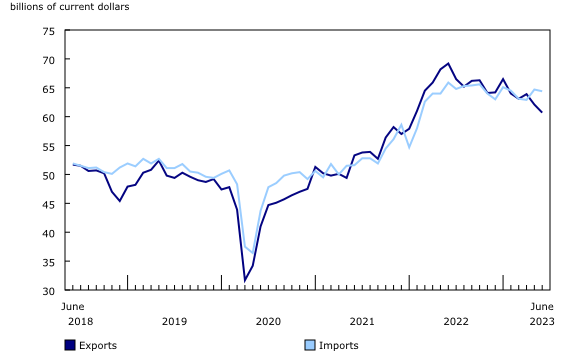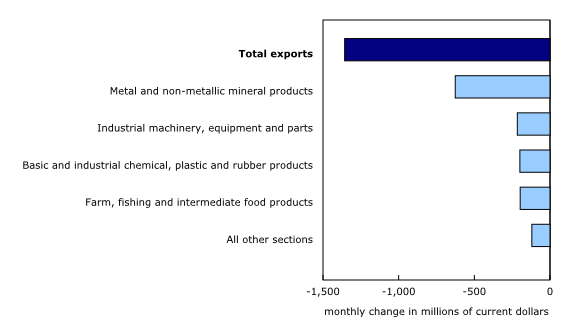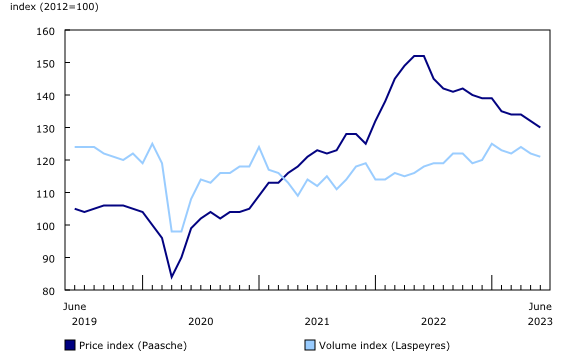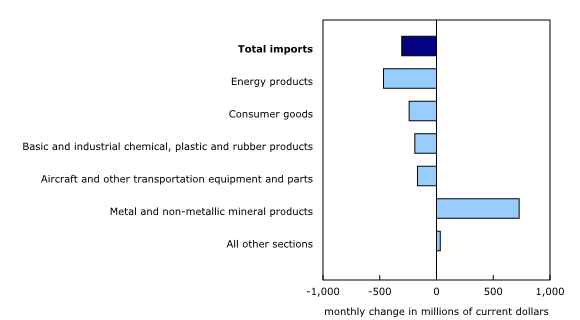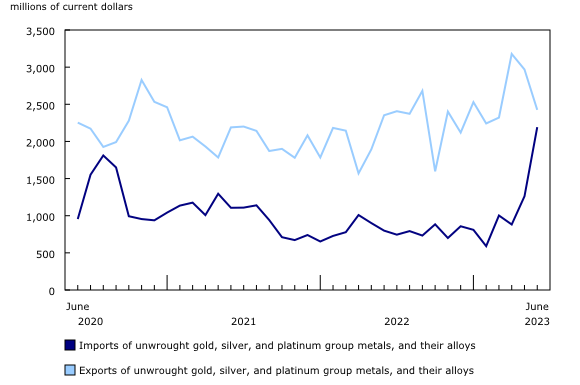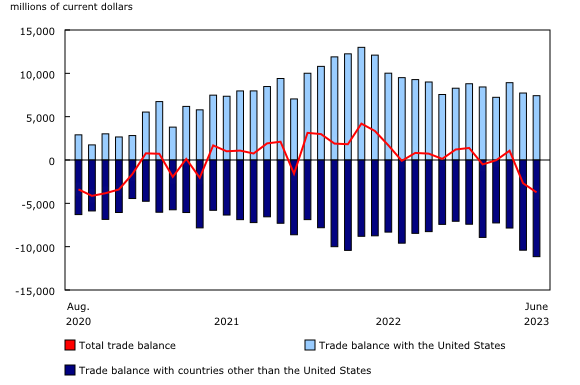Canadian international merchandise trade, June 2023
Released: 2023-08-08
In June, Canada's merchandise exports decreased 2.2%, while imports were down 0.5%. As a result, Canada's merchandise trade deficit with the world widened from $2.7 billion in May to $3.7 billion in June.
Consult the "International trade monthly interactive dashboard" to explore the most recent results of Canada's international trade in an interactive format.
Recent port disruptions and international trade statistics
Strike at British Columbia marine port terminals
A port strike that significantly affected activity at British Columbia marine terminals began on July 1 and disrupted regular operations for more than 13 days. Canada's international merchandise trade, especially with Asian countries, relies heavily on these ports to move goods. As a result of the strike, impacts on Canadian merchandise trade activity are anticipated for the reference month of July, in particular for containerized shipments. Statistics for the July reference month will be published on September 6.
In 2022, 9.2% of Canada's total exports by value were shipped through British Columbia via marine transportation. For imports, 5.0% of the total value was cleared by B.C. marine ports in 2022. Over half of exports through B.C. ports were resource-based goods, ranging from mined commodities such as coal and potash to agricultural and forestry products, including wheat, canola and pulp and paper. Many of these goods are shipped in bulk, and are expected to be less impacted by strike activity in July. Imported goods arriving through B.C. ports included many finished consumer products as well as intermediate goods used in various industries.
International trade statistics do not include in-transit shipments, which reflect shipments between two countries that rely in part on a third country's transportation infrastructure—for instance, cargo from overseas that is off-loaded at a B.C. port and then transported directly to the US by road or rail. As is consistent with international standards, in-transit shipments are excluded from Canadian International Merchandise Trade statistics. Among other factors, this may give rise to differences between the official trade data and the dollar value estimates of trade being reported in other media outlets and port operation authorities.
Severe flooding in Nova Scotia
Significant rainfall on July 21 led to flooding that damaged a section of the rail line that serves the port of Halifax. In 2022, the Halifax marine port cleared 1.4% of Canada's total merchandise import value. In the same year, 0.8% of total exports were shipped from this port by water. The rail disruption caused by the flooding in July 2023 limited the ability of goods to travel further inland, and while marine terminals continued to operate normally, this could have an impact on merchandise trade activity. Rail service to the port had resumed by the end of July.
Merchandise exports decline for the second consecutive month
Following a 3.0% decrease in May, total exports were down 2.2% in June, with 9 of the 11 product sections posting declines. Total exports in real (or volume) terms fell 1.1% in June. As for export prices, they declined for the 11th time in the past 12 months. From June 2022 to June 2023, total export prices decreased 14.2%. However, during the same period, the value of total exports declined 12.3%, meaning that exports in real terms in fact increased.
Exports of metal and non-metallic mineral products decreased 8.0% in June, mainly because of lower exports of unwrought gold, silver, and platinum group metals, and their alloys (-18.3%). Following high levels observed in April and May, exports of unwrought gold declined sharply in June, primarily because of the decline in gold shipments to the United States and Hong Kong. This decline was the result of both lower exports of refined gold and decreased gold asset transfers in the banking sector.
Several other product sections had similar contributions to the decline in exports in June, mainly because of lower volumes. This includes exports of industrial machinery, equipment and parts (-5.0%), which decreased in part because of the decline in exports of parts of industrial machinery and equipment (-9.6%); exports of basic and industrial chemical, plastic and rubber products (-5.7%); and exports of farm, fishing and intermediate food products (-4.4%), which decreased notably because of the decline in exports of canola (-42.4%) and intermediate food products (-15.0%).
Imports of energy products and consumer goods decline, while imports of gold increase
After rising 3.0% in May, total imports decreased 0.5% in June. While 7 of the 11 product sections posted declines, these were largely offset by the increase in imports of unwrought gold. In real (or volume) terms, imports were up 0.9%.
Imports of energy products were down 13.0% in June, a fifth decrease in 2023. Imports of refined petroleum energy products (-17.0%) posted the largest decline, mainly because of weaker imports of motor gasoline. Imports of motor gasoline increased significantly in June 2022, and this type of variation did not repeat in June 2023. After rising 23.2% in May, imports of crude oil (-9.5%) also contributed to the decline in June, mainly on decreases in imports from Saudi Arabia and Nigeria.
Imports of consumer goods were down 1.9% in June, largely because of lower imports of pharmaceutical products (-7.2%). These imports have shown significant variations since early 2023, mainly because of imports of active pharmaceutical ingredients, which are used in the production of new medications. The medications produced are then often exported to other countries. Exports of pharmaceutical products rose 27.4% in June.
Imports of metal and non-metallic mineral products (+12.9%) posted a second consecutive strong monthly increase and partially offset the overall decrease in imports in June. As in the previous month, imports of unwrought gold, silver, and platinum group metals, and their alloys (+73.9%) contributed the most to the gain. While imports of silver drove the increase in May, imports of unwrought gold increased the most in June, mainly on growth in gold asset transfers within the banking sector.
The deficit with countries other than the United States reaches an all-time high
In June, exports to countries other than the United States decreased 5.5%, while imports from these countries edged down 0.1%. As a result, Canada's merchandise trade deficit with countries other than the United States rose from $10.4 billion in May to a record high of $11.2 billion in June.
In June, exports to the United States were down 1.2%, while imports decreased 0.7%. As a result, Canada's trade surplus with the United States narrowed from $7.7 billion in May to $7.4 billion in June.
Quarterly nominal exports decrease more than imports
In the second quarter of 2023, exports decreased 3.5%, a fourth consecutive quarterly decline. Exports of energy products (-9.0%) and farm, fishing and intermediate food products (-19.5%) drove the quarterly decrease. Excluding these two product sections, exports edged up 0.2% in the second quarter.
After a slight increase of 0.1% in the first quarter, imports were down 0.3% in the second quarter. The decrease in imports of energy products (-15.7%) and industrial machinery, equipment and parts (-4.6%) was partly offset by the rise in imports of motor vehicles and parts (+5.6%) and metal and non-metallic mineral products (+10.5%).
In real terms, quarterly imports increase, while exports decrease
In real terms (calculated using chained 2012 dollars), exports fell 0.4% in the second quarter of 2023. Real exports of farm, fishing and intermediate food products (-14.8%) contributed the most to the decline. This decrease was partly offset by the increase in exports of motor vehicles and parts (+5.6%).
Real imports were up 0.9% in the second quarter; this increase occurred after three consecutive quarterly declines. Imports of metal and non-metallic mineral products (+15.4%) and motor vehicles and parts (+5.3%) increased the most in the second quarter.
Revisions to May merchandise export and import data
Imports in May, originally reported at $65.0 billion in the previous release, were revised to $64.7 billion in the current reference month. Exports in May, originally reported at $61.5 billion in the previous release, were revised to $62.0 billion in the current reference month's release.
Monthly trade in services
In June, monthly service exports increased 0.4% to $14.7 billion. Meanwhile, service imports were down 0.2% to $15.7 billion.
When international trade in goods and services are combined, exports decreased 1.7% to $75.4 billion in June, while imports decreased 0.4% to $80.1 billion. As a result, Canada's trade balance with the world went from a deficit of $3.8 billion in May to a deficit of $4.7 billion in June.
Note to readers
Merchandise trade is one component of Canada's international balance of payments (BOP), which also includes trade in services, investment income, current transfers, and capital and financial flows.
International trade data by commodity are available on both a BOP and a customs basis. International trade data by country are available on a customs basis for all countries and on a BOP basis for Canada's 27 principal trading partners (PTPs). The list of PTPs is based on their annual share of total merchandise trade—imports and exports—with Canada in 2012. BOP data are derived from customs data by adjusting for factors such as valuation, coverage, timing, and residency. These adjustments are made to conform to the concepts and definitions of the Canadian System of National Accounts.
For a conceptual analysis of BOP-based data versus customs-based data, see "Balance of Payments trade in goods at Statistics Canada: Expanding geographic detail to 27 principal trading partners."
For more information on these and other macroeconomic concepts, see the Methodological Guide: Canadian System of Macroeconomic Accounts (13-607-X) and the User Guide: Canadian System of Macroeconomic Accounts (13-606-G).
The data in this release are on a BOP basis and are seasonally adjusted. Unless otherwise stated, values are expressed in nominal terms, or current dollars. References to prices are based on aggregate Paasche (current-weighted) price indexes (2012=100). Movements within aggregate Paasche prices can be influenced by changes in the share of values traded for specific goods, with sudden shifts in trading patterns—as observed with the COVID-19 pandemic—sometimes resulting in large movements in Paasche price indexes. Volumes, or constant dollars, are calculated using the Laspeyres formula (2012=100), unless otherwise stated.
For information on seasonal adjustment, see Seasonally adjusted data – Frequently asked questions.
Revisions
In general, merchandise trade data are revised on an ongoing basis for each month of the current year. Current-year revisions are reflected in both the customs-based and the BOP-based data.
The previous year's customs-based data are revised with the release of data for the January and February reference months, and thereafter on a quarterly basis. The previous two years of customs-based data are revised annually, and revisions are released in February with the December reference month.
The previous year's BOP-based data are revised with the release of data for the January, February, March and April reference months. To remain consistent with the Canadian System of Macroeconomic Accounts, revisions to BOP-based data for previous years are released annually in December with the October reference month.
Factors influencing revisions include the late receipt of import and export documentation, incorrect information on customs forms, the replacement of estimates produced for the energy section with actual figures, changes in merchandise classification based on more current information, and changes to seasonal adjustment factors. The seasonal adjustment parameters are reviewed and updated annually and applied with the October reference month release.
For information on data revisions for exports of energy products, see "Methodology for Exports of Energy Products within the International Merchandise Trade Program."
Revised data are available in the appropriate tables.
Upcoming changes within the Canadian International Merchandise Trade program
In the fall of 2023, Statistics Canada will be updating the North American Product Classification System (NAPCS) used for merchandise import and export statistics. The NAPCS 2022 version will replace NAPCS 2017, which is the version currently in use. Additionally, the reference year applicable to merchandise trade price and volume statistics will be updated from 2012 to 2017 (2017=100).
Nominal values based on NAPCS 2022 for the periods January 1988 to October 2023 will be published on December 6, 2023. At the same time, price and volume statistics for the new reference year will be published for the periods January 2017 to October 2023. These changes will be reflected in the third quarter statistics for the Balance of International Payments and gross domestic product, which are scheduled to be published in November 2023.
For more information, please see NAPCS 2022 and Variant of NAPCS Canada 2022 Version 1.0 - Merchandise import and export accounts (forthcoming), or contact International Accounts and Trade Division Client Services at itdtrade@statcan.gc.ca.
Real-time data table
The real-time data table 12-10-0120-01 will be updated on August 21.
Next release
Data on Canadian international merchandise trade for July will be released on September 6.
Products
The product "International trade monthly interactive dashboard" (71-607-X) is now available. This new interactive dashboard is a comprehensive analytical tool that presents monthly changes in Canada's international merchandise trade data on a balance-of-payments basis, fully supporting the information presented every month in the Daily release.
The product "The International Trade Explorer" (71-607-X) is now available online.
The Canadian International Merchandise Trade online database is no longer available. It has been replaced by the Canadian International Merchandise Trade Web Application (71-607-X), a modern tool that provides trade data users with a number of enhancements.
The updated "Canada and the World Statistics Hub" (13-609-X) is now available online. This product illustrates the nature and extent of Canada's economic and financial relationship with the world using interactive charts and tables. It provides easy access to information on trade, investment, employment and travel between Canada and a number of countries, including the United States, the United Kingdom, Mexico, China, Japan, Belgium, Italy, the Netherlands, and Spain.
Contact information
For more information, or to enquire about the concepts, methods or data quality of this release, contact us (toll-free 1-800-263-1136; 514-283-8300; infostats@statcan.gc.ca) or Media Relations (statcan.mediahotline-ligneinfomedias.statcan@statcan.gc.ca).
- Date modified:


